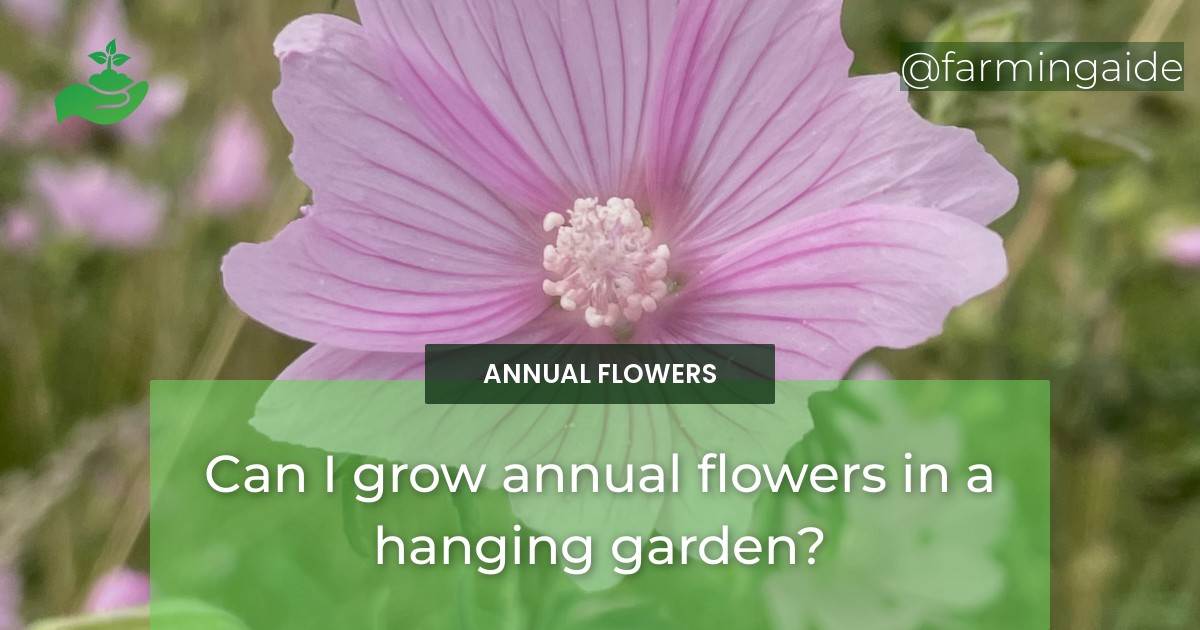Yes, you can grow annual flowers in a hanging garden. Creating a hanging garden is a great way of adding color and texture to your outdoor spaces. Hanging gardens are perfect for annual flowers that grow and bloom throughout the growing season. The trailing varieties of annual flowers are well-suited for hanging gardens as they grow downwards and provide a cascading effect.
Techniques for growing annual flowers in hanging gardens
Choosing the right location for your hanging garden
The first step in growing annual flowers in a hanging garden is choosing the right location. You need to select a location that receives enough sunlight and is sheltered from strong winds. Hanging gardens can be hung from walls, railings, or even tree branches.
Selecting the suitable container for your annual flowers
The choice of container is important when growing annual flowers in a hanging garden. The container should be large enough to hold the soil and provide enough space for the plants to grow. You can choose from baskets, window boxes, hanging pouches, or wall planters.
Picking the right soil for your hanging garden
The soil is essential for the growth of annual flowers in a hanging garden. You need to choose a soil mix that is well-draining and provides enough nutrients for the plants. You can use a mix of potting soil and perlite or vermiculite for your hanging garden.
Selecting trailing varieties of annual flowers
The trailing varieties of annual flowers are perfect for hanging gardens. You can choose from petunias, lobelias, sweet alyssum, verbena, and nasturtium. These plants grow downwards and provide a cascading effect that is perfect for hanging gardens.
Providing adequate water and nutrients for your hanging garden
Water and nutrients are essential for the growth of annual flowers in a hanging garden. You need to water your plants regularly and provide enough nutrients for them to grow. You can use a liquid fertilizer that is diluted in water and apply it to your plants once a week.
Maintaining your hanging garden
Maintaining your hanging garden is important for the growth and health of your plants. You need to deadhead your plants regularly and prune them to keep them in shape. You also need to control pests and diseases and ensure proper watering and drainage.
Suitable trailing varieties for annual flowers in hanging gardens
Petunias
Petunias are a popular choice for hanging gardens as they produce beautiful flowers that come in a variety of colors. They are easy to care for and bloom throughout the growing season.
Lobelias
Lobelias are another great choice for hanging gardens. They produce delicate blue flowers and grow downwards, creating a cascading effect.
Sweet Alyssum
Sweet Alyssum produces clusters of tiny flowers that come in white, pink, and purple colors. They are easy to grow and add a sweet fragrance to your hanging garden.
Verbena
Verbena produces clusters of small flowers that come in a variety of colors. They are perfect for hanging gardens as they grow downwards and provide a cascading effect.
Nasturtium
Nasturtium produces beautiful flowers that come in a range of colors from yellow to orange and red. They are easy to grow and attract butterflies and hummingbirds to your garden.
ALSO READ
Container choices for annual flowers in hanging gardens
Baskets
Baskets are a popular choice for hanging gardens. They come in a variety of materials such as wicker and metal and are perfect for trailing varieties of annual flowers.
Window boxes
Window boxes are another great choice for hanging gardens. They can be hung from windowsills or even fences and are perfect for small spaces.
Hanging pouches
Hanging pouches are a unique option for hanging gardens. They are made of materials such as felt or fabric and are perfect for small annual flowers.
Wall planters
Wall planters are a great option for hanging gardens as they can be hung on walls or fences. They come in a variety of sizes and materials such as metal and wood.
Tips for maintaining your annual flowers in a hanging garden
Regular deadheading
Deadheading is the process of removing dead flowers from your plants. This helps to promote new growth and keeps your plants looking neat and tidy.
Pruning and shaping
Pruning and shaping your plants is important for their growth and health. You need to remove dead or damaged branches and shape your plants to keep them in shape.
Fertilizing
Fertilizing your plants is important for their growth and health. You can use a liquid fertilizer that is diluted in water and apply it to your plants once a week.
Controlling pests and diseases
Pests and diseases can wreak havoc on your plants. You need to control pests such as aphids and caterpillars and treat diseases such as powdery mildew.
Watering and drainage
Watering and drainage are essential for the growth of your plants. You need to water your plants regularly and ensure that the container has adequate drainage to prevent root rot.
Will Annual Flowers Thrive in Different Types of Garden Settings?
Yes, growing annual flowers in raised bed gardens can be a great option for many gardeners. Raised beds provide good drainage, warmer soil, and reduce the risk of weeds and pests. With proper care and attention, annual flowers can thrive in raised bed gardens, adding vibrant color and beauty to any landscape.
Conclusion
Recap of the techniques and tips for growing annual flowers in a hanging garden
Growing annual flowers in a hanging garden is a great way of adding color and texture to your outdoor spaces. You need to choose the right location, container, and soil mix for your plants. Trailing varieties of annual flowers are perfect for hanging gardens as they grow downwards and provide a cascading effect. You need to provide adequate water and nutrients for your plants and maintain them by deadheading, pruning, and shaping. Controlling pests and diseases and ensuring proper watering and drainage will help to keep your plants healthy and beautiful.


